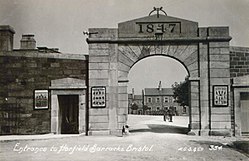Horfield Barracks
| Horfield Barracks | |
|---|---|
| Bristol | |

Horfield Barracks
|
|
|
Location within Bristol
|
|
| Coordinates | 51°29′32″N 2°35′00″W / 51.49229°N 2.58330°WCoordinates: 51°29′32″N 2°35′00″W / 51.49229°N 2.58330°W |
| Type | Barracks |
| Site information | |
| Owner | Ministry of Defence |
| Operator |
|
| Site history | |
| Built | 1843–1847 |
| Built for | War Office |
| In use | 1847-1966 |
| Garrison information | |
| Occupants | 3rd Battalion the Gloucestershire Regiment |
Horfield Barracks is a former military installation in the Horfield area of Bristol.
The barracks were built, largely in response to the Bristol riots of 1831, and completed between 1843 and 1847. During the Crimean War a mutiny took place and in 1868 a sergeant murdered a private soldier in a dispute over money. In 1873 a system of recruiting areas based on counties was instituted under the Cardwell Reforms and the barracks became the depot for the 28th (North Gloucestershire) Regiment of Foot and the 61st (South Gloucestershire) Regiment of Foot. Following the Childers Reforms, the 28th and 61st regiments amalgamated to form the Gloucestershire Regiment with its depot in the barracks in 1881. A 3rd battalion of that regiment also established itself at Horfield Barracks.
During the First World War the barracks also served as the 5th cavalry depot providing accommodation for the 3rd The King's Own Hussars, the 7th Queen's Own Hussars, the 15th The King's Hussars and the 19th Royal Hussars. The barracks were decommissioned after the Second World War and demolished in 1966. The site became a telephone engineering works in the late 1960s and was redeveloped for housing in around 2000.
...
Wikipedia

